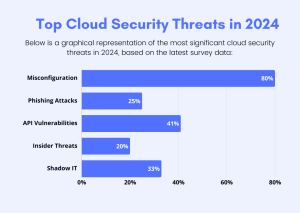Cloud computing has become the backbone of modern businesses, with over 94% of enterprises using cloud services in some capacity. However, as the cloud continues to grow in adoption, so does the sophistication and frequency of threats targeting it. A recent survey revealed that 93% of organizations are moderately to extremely concerned about cloud security, making it a critical focus for 2024.

STAATSE — Cloud Security Services
Why is Cloud Security Important?
Cloud environments host sensitive data, customer information, and business-critical applications. A breach could lead to:
- Data Loss or Theft: Exposing sensitive customer or company data.
- Financial Loss: Recovery costs, regulatory fines, and loss of customer trust.
- Downtime: Business operations disrupted, impacting productivity and revenue.
With the global cloud market expected to reach $832.1 billion by 2025, protecting these assets is paramount.
Top Cloud Security Threats in 2024

- Misconfiguration of Cloud Settings
According to industry reports, 80% of cloud security breaches are due to human error and misconfiguration. Examples include:
-
- Publicly exposed databases.
- Overly permissive access controls.
- Phishing Attacks Targeting Cloud Credentials
Phishing attacks continue to evolve, with cybercriminals now specifically targeting cloud-based email and collaboration tools. The Verizon 2023 Data Breach Investigations Report states that 25% of data breaches involved phishing.
- Inadequate Identity and Access Management (IAM)
Weak IAM policies can lead to unauthorized access to sensitive cloud resources. Over 50% of organizations admit to having at least one excessive privilege issue per week, according to Gartner.
- API Vulnerabilities
APIs are the backbone of cloud interactions but can also be an attack vector. 41% of organizations experienced API security incidents in 2023, as reported by Salt Security.
- Ransomware in the Cloud
Ransomware attacks are now targeting cloud environments through compromised backups or synced devices. Ransomware attacks increased by 13% in 2023, making it a persistent threat.
- Shadow IT
Unauthorized use of cloud services by employees bypassing IT policies creates vulnerabilities. 33% of security breaches are linked to shadow IT, according to McAfee.
- Insider Threats
Malicious or negligent employees pose significant risks. In 2023, insider threats accounted for 20% of cloud security incidents, based on a study by Ponemon Institute.
STAATSE — Cloud Security Services
Emerging Trends in Cloud Security
- Zero Trust Architecture: More organizations are adopting zero trust principles to minimize the attack surface.
- Cloud-Native Security Tools: Use tools specifically designed for the cloud to enhance protection.
- AI-Powered Threat Detection: AI and machine learning are becoming crucial in identifying and mitigating threats in real-time.
Conclusion
Cloud security is not a one-time effort but an ongoing process. Organizations must stay vigilant, adopt best practices, and leverage advanced technologies to combat evolving threats. As we move into 2024, understanding and addressing these risks proactively will ensure that businesses can reap the benefits of the cloud without compromising on security.
Data Credits
Data and statistics cited in this article are sourced from the following:
- Verizon 2023 Data Breach Investigations Report
- Salt Security API Security Trends Report 2023
- McAfee Cloud Security Insights
- Ponemon Institute Insider Threats Report 2023
- Gartner IAM Practices and Insights 2023